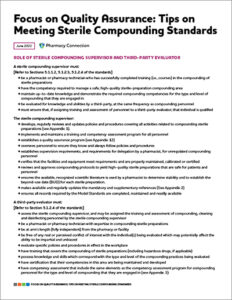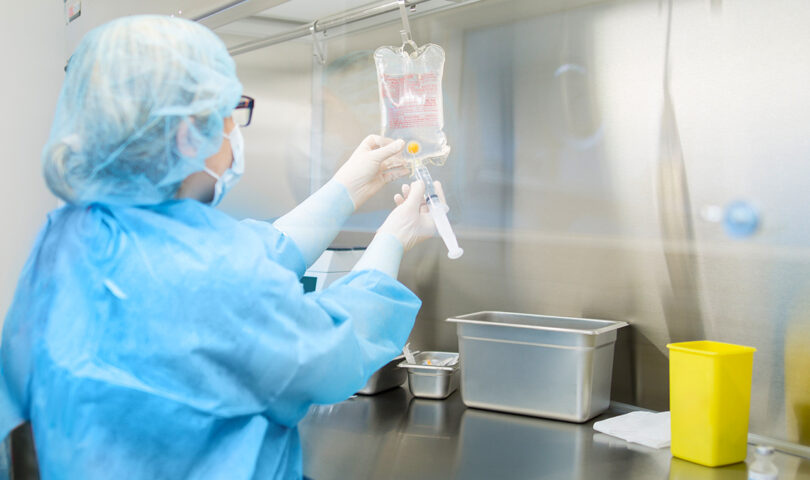Compounding sterile preparations is a high-risk activity which requires compliance with comprehensive standards to ensure the overall quality of the preparation and the safety of patients and compounding personnel. College Operations Advisors conduct routine assessments of pharmacies engaged in sterile compounding to evaluate adherence to the standards. These routine assessments also provide an opportunity to share resources and guidance to assist pharmacies in carrying out the required sterile compounding activities, including establishing a pharmacy-specific quality assurance (QA) program to meet the intended outcomes.
Pharmacy Connection asked Operations Advisors to offer insight on key QA program requirements. Here’s what they had to say.
Establish Verification Processes
Refer to Section 7: QUALITY ASSURANCE PROGRAM and APPENDIX 12: COMPONENTS OF A QUALITY ASSURANCE PROGRAM
NAPRA hazardous and non-hazardous sterile compounding standards require the sterile compounding supervisor to establish a pharmacy-specific QA program for verification of facilities, equipment and personnel that affect safety and the quality of compounded sterile preparations. This QA program is intended to generate information indicating that the conditions and established procedures required for contamination-free compounded sterile preparations are attained and maintained.
The QA program must have four main components:
- Verification of equipment, including the Primary Engineering Control(s)
- Verification of facilities, including the clean room and anteroom (Secondary Engineering Controls)
- Verification of personnel competency in aseptic compounding processes (e.g., Media Fill Test, GFS, etc.)
- Verification of final compounded sterile preparations
Assign Results to Verification Processes
For each of the four main components of the QA program, the results of the verification process must be assigned one of three levels by the sterile compounding supervisor:
- Compliance (no action required): mandatory specifications have been attained.
- Alert (tendency toward non-compliance): increased vigilance is required to prevent non-compliance.
- Action required (non-compliant): more in-depth investigation, immediate corrective action and/or preventive action are needed to avoid return to non-compliance.
Analyze Results
The verifications required by the QA program provide valuable data to allow the sterile compounding supervisor to identify trends concerning microbial load in controlled areas and types of microorganisms found. This allows corrective and preventive actions to be taken, if necessary. When appropriate, the sterile compounding supervisor should consult a microbiologist or infectious diseases specialist.
Document and Act on Results
To act on the results of the verification process, the sterile compounding supervisor must have protocols in place to investigate non-compliance and deviations from policies and procedures. These protocols must outline the necessary corrective and preventive actions to achieve compliance.
When corrective measures are implemented to address non-compliance (e.g., additional training, etc.) verifications should be repeated to determine their effectiveness and if additional action may be required. Consultation with a microbiologist or infectious diseases specialist may be necessary.
Written documentation related to the QA program must be retained. This information is made available to, and used by, compounding personnel and other responsible individuals, such as the Designated Manager in a community pharmacy or the pharmacy manager/administrator in a hospital pharmacy.
Test your knowledge
Use the below educational tool to anonymously test your knowledge of the sterile compounding standards.
Additional resources

Download the “Role of sterile compounding supervisor and third-party evaluator” pdf













